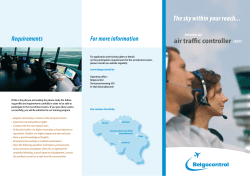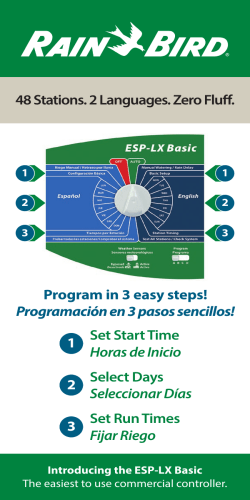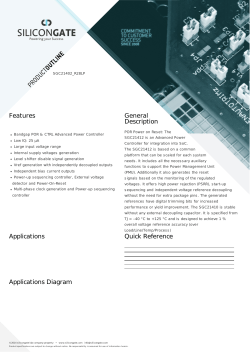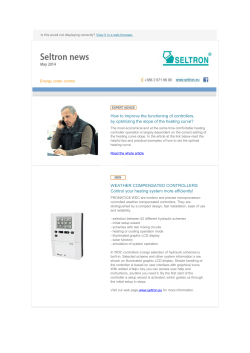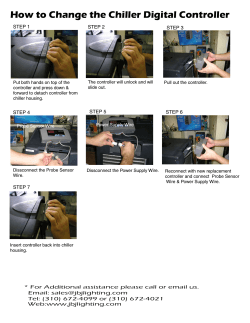
Design of Control Structure for Binary Distillation Column
International Conference on Chemical, Civil and Environmental Engineering (ICCCEE'2015) March 23-24, 2015 London (UK) Design of Control Structure for Binary Distillation Column Ramsagar Vooradi, and Sarath Babu Anne guidelines for selecting suitable controller variables and corresponding manipulated variables for distillation columns. Lot of work has been carried out on the control of distillation columns, but the study on the response of the process subjected to various disturbances with different control structures has not been attempted. Luyben [2] presented steady state design of the distillation column and carried out dynamic simulation focusing on tuning of controllers at default ranges and the controller parameters were calculated using Tyreus–Luyben Tuning rule. In this paper, the performance of the binary distillation column has been studied with different control structures. Controller parameters have been calculated by using Tyreus– Luyben and Ziegler-Nicholas tuning rules. The column response has been observed subjecting it to various disturbances. Abstract----Design of control structure for distillation columns is an important aspect in order to minimize the damage caused due to unexpected disturbances. In this study, the dynamic simulation of a distillation column has been carried out using Aspen Dynamics. For the purpose of the present study, a binary mixture of propaneisobutane is selected. The distillation column has been first designed at steady state using DSTWU model, a shortcut design model in Aspen Plus. The design is fine-tuned and the column is sized with RADFRAC model, a rigorous rating model using the design data obtained from the DSTWU model. The steady state simulation has been exported to Aspen Dynamics under pressure driven simulation mode for carrying out dynamic simulation. The steady-state design parameters of the column are used as initial conditions for the dynamic simulation. The Dynamic simulation of the distillation column has been carried with three different processes, which are classified based on the control structure used as: Process-1 controls the composition of top product using the temperature controller; Process-2 controls the composition of top product using a composition controller and Process-3 controls the composition using a cascade of temperature and composition controllers. The tuning of different controllers has been performed using the Relay AutoTuning test, and the control parameters have been calculated using Tyreus-Luyben and Ziegler-Nicholas tuning rules. The dynamic response of the three processes mentioned above has been studied subjecting them to various disturbances. The major conclusions drawn from this study are: The temperature controller alone (ProcessI) is not suitable to control both top and bottom product compositions, when the step disturbance in feed composition is given. Though the composition controller (Process-II) is able to maintain the desired compositions of the top and bottom products, the response of the system is very poor. The response has been observed to be fast and without any oscillations in case of Process-III when compared to both Process-I and Process-II. II. PROBLEM DEFINITION In the present study dynamic simulation of a distillation column has been carried out using Aspen Dynamics to develop different control strategies. The distillation column is used to separate the binary mixture of propane and isobutene feed with the following specifications [2]: Feed: flow rate is 1 mol/s, temperature is 322 K, pressure is 21 atm, composition:- 40 mol% propane and 60 mol% isobutane. Product Specifications: Isobutane should not exceed 2 mol% in the distillate and propane should not exceed 1 mol% in the bottoms. III. METHODOLOGY Keywords----Aspen, Control structure, Distillation Column, Tyreus-Luyben, Ziegler-Nicholas. I. INTRODUCTION S EVERAL aspects of operation and design of the depropanizer process have been discussed at length but none addresses the issue of control structure design in a systematic manner. Choosing a proper control structure for distillation columns along with optimum controller parameters is important to maintain desired product quality, production rate, and minimize the energy usage. Kister [1] suggested A. Steady State Process Simulation Steady state simulation of the column is first carried out by DSTWU model, a short cut design model followed by RADFRAC model, a rigorous rating model. In order to carry out “simultaneous design” (steady state and dynamic), pumps and control valves must be included to permit a “pressuredriven” dynamic simulation. The necessary pumps and control valves are added to the flowsheet as shown in Fig. 1. OUTPUMP1 http://dx.doi.org/10.15242/IIE.E0315071 133 TOPPROD TOP V1 IPVAL Ramsagar Vooradi is with National Institute of Technology, Department of Chemical Engineering, Warangal–506004, AP, INDIA. (phone: +918332969406; e-mail: [email protected]). Sarath Babu Anne, is with National Institute of Technology, Department of Chemical Engineering, Warangal–506004, AP, INDIA. (phone: +919492273973; e-mail: [email protected]). V2 PUMP1 COL IPCOL PUMP2 V3 OUTPUMP2 BOTPROD BOT Fig. 1 Steady State Simulation Flowsheet International Conference on Chemical, Civil and Environmental Engineering (ICCCEE'2015) March 23-24, 2015 London (UK) As the data from shortcut method is used for the rigorous RADFRAC column, the results of the simulation did not give the required purities. In order to achieve the required purities, using the RADFRAC column, design specifications are used to fine tune some of the input parameters. Two design specifications, one each for the top and bottom product purities and the manipulated variables chosen are: reflux ratio and distillate rate respectively. B. Dynamic Simulation In order to convert the steady-state simulation into a dynamic mode, the additional information that must be provided is the physical dimensions of all the equipment. The diameter of the column has been calculated by carrying out tray sizing. The sizes of the reflux drum and the column base have been calculated using simple heuristics. The dimensions of the reflux drum used are 4.08 m in diameter and 8.16 m in length, while that of the column base are 5.08 m in diameter and 10.16 m in length. When the steady state is converted into dynamic mode only one default controller, the pressure controller is added which is configured to measure condenser pressure by manipulating condenser heat removal. The following four additional controllers have been added to achieve effective operation of the column:[3] 1. Reflux drum-level controller 2. Base-level controller 3. Feedflow controller 4. Tray temperature or composition controller or cascade controller The selection of the manipulated variables to control each of the above four measured variables is the issue while selecting the control structure. The details of all the four controllers used are tabulated as shown in the following table. TABLE I CONTROLLER SPECIFICATION TABLE Type of controller Controlled Manipulated variable variable Reflux drum-level (lc12) Base-level (lc11) Reflux drum-level Base-level Feed flow Feed flow rate 9th stage temperature Distillate composition Distillate composition Temperature Composition Primary Cascade Secondary th 9 stage temperature Fig. 2 Dynamic Simulation Flowsheet for Process-I Fig. 3 Dynamic Simulation Flowsheet for Process-II Fig. 4 Dynamic Simulation Flowsheet for Process-III Dead time(min) % opening of valve v2 % opening of valve v3 % opening of valve v1 Reboiler duty 0 Reboiler duty 3 Setpoint of Secondary controller Reboiler duty 3 TABLE II LIST OF CONTROLLERS IN THE PROCESS Process Controllers used Process-I Pressure, Reflux drum-level, Baselevel, Feed flow, Temperature. Process-II Pressure, Reflux drum-level, Baselevel, Feed flow, Composition. Process-III Pressure, Reflux drum-level, Baselevel, Feed flow, Cascade. 0 0 1 IV. RESULTS AND DISCUSSION 1 C. Reflux to feed ratio The R/F ratio scheme should do a pretty good job of maintaining product purities in the propane/iso-butane system in case of feed composition disturbances and feed flow rate changes. The R/F structure is implemented by using a multiplier block. The input of this block is the mass flow rate of the feed, while its output is the mass flow rate of the reflux. http://dx.doi.org/10.15242/IIE.E0315071 D. Selection of Control Tray for Process-I The appropriate location for the temperature or composition sensor is usually chosen based on any one method: slope criterion, sensitivity criterion etc. in this study 9th stage has been selected as the controller tray based on the slope criterion. The column has been studied with three different control structures which are named as process-I, II and III as shown in Figures 2, 3 and 4. The list of controllers used in these three processes are given in Table-2. A. Steady State Results The Steady State simulation results with RADFRAC column obtained without the use of any design specifications are shown in Table-3. It can be observed that the top and bottom product purities obtained are not upto the desired requirement. The desired purities with respect to both top and bottom products can be achieved by using two design specifications, one each for the top and bottom product purities and the manipulated variables chosen are: reflux ratio and distillate rate respectively. 134 International Conference on Chemical, Civil and Environmental Engineering (ICCCEE'2015) March 23-24, 2015 London (UK) The results of the two design specifications are shown in B. Dynamic Simulation Results Tables 4 and 5 respectively. It can be observed that the value of The acceptable ranges of top and bottom product reflux ratio and distillate rate are 3.51 and 0.402 respectively, compositions for all processes are shown in Table 7. to get the desired top and bottom product purities. TABLE VII ACCEPTABLE RANGE OF PRODUCTS Product composition Design Acceptable range (Mole Fraction) specification (within +5% of its final value) DISTILLATE (ISO0.02 0.019 - 0.021 BUTANE) BOTTOMS 0.01 0.0095 - 0.0105 (PROPANE) TABLE III DETAILED DESIGN STREAM RESULTS 1) Tuning of Controllers The ultimate gain and ultimate period have been found by conducting Relay Auto-Tuning test with the default ranges and the Controller parameters have been calculated using TyreusLuyben (T-L) and Ziegler-Nicholas (Z-N) tuning rules. The results of all the controllers are shown in Table 8. TABLE IV DESIGN SPECIFICATION-1 RESULTS TABLE VIII CONTROLLER PARAMETER RESULTS TYREUS-LUYBEN Kc 1.572 τI 11.22 ZIEGLERNICHOLS KC τI 2.2640 4.25 0.11 86.064 0.158 32.6 1.572 11.22 2.264 4.25 0.073 49.236 0.106 18.6 PROCESS PROCESS-I PROCESS-II TABLE V DESIGN SPECIFICATION-2 RESULTS PROCESSIII TEMPERATURE CONTROLLER COMPOSITIONCONTROLLER TEMPERATURE CONTROLLER COMPOSITIONCONTROLLER The Ziegler–Nichols settings work well for a small range of dead time to time constant ratio D/τ, and the performance starts to degrade for D/τ <0.2 and D/τ >2. A more conservative tuning rule is proposed by Tyreus and Luyben which works well for the time-constant dominant processes[4]. 2) Reflux to Feed Ratio The R/F structure is implemented by using a multiplier block. With the help of multiplier block the reflux flow rate is maintained constant irrespective of the disturbance but the The diameter of the column has been obtained as 5.94 m reflux flow rate will change when feed composition or feed from the tray sizing results as shown in the Table 6. flow rate changes. TABLE VI TRAY SIZING RESULTS http://dx.doi.org/10.15242/IIE.E0315071 C. Performance Evaluation 1) Feed Flow Controller Set Point Change for Process-I Process-I is subjected to a 0.05 kmol/s of step change to the set point of flow controller and its response is observed when reflux drum level controller has the following set of controller parameters: Case-1: Controller gain = 2 and integral time=9999. Case-2: Controller gain = 1and integral time=20. 135 International Conference on Chemical, Civil and Environmental Engineering (ICCCEE'2015) March 23-24, 2015 London (UK) Fig. 8 Response of Process-II Fig. 5 Response of Process-I for Case-1 Fig. 9 Response of Process-III with T-L tuning Fig. 6 Response of Process-I for Case-2 The process has been observed to show a good response for Case-1 conditions, i.e., high gain and low integral action (proportional action). From Fig. 5 it has been observed that the process exhibits less oscillatory behavior and response time of process for Case-1 is 8.5 hours. However, the use of proportional controller has been observed to result in some offset. With respect to Case-2, it has been observed that the process exhibits high oscillatory behavior and the response time of process is 17.5 hours as shown in Fig. 6. This is essentially as a result of the high integral time. The level controller (LC12) in this case did not result in any off-set. But the response time is much more than that of Case-1. From this observation it can be concluded that level controllers can be configured with proportional action if the off-set is tolerable. In this work the two level controllers have been configured with proportional action in all the processes. 2) Composition Disturbance The performance of all the three Processes has been studied by subjecting them to a step disturbance in feed composition. The mole fractions of propane and iso-butane have been changed from 0.40/0.60 to 0.50/0.50. The responses of different processes are shown in Figures 7, 8, 9 and 10. In case of Process-II, the product compositions have been maintained at the desired level unlike the case of Process-I. However, the response of Process-II has been found to be very poor, when compare with that of Process-I. This is because of very low controller gain and the very large integral time. Hence it can be concluded that Process-II alone may not be suitable for obtaining a fast response and tight controller action. Response time of process-II is 9 hours. Fig. 10 Response of Process-III with Z-N tuning Process-III, as defined earlier, makes use of a cascade of temperature and composition controllers as primary and secondary controllers respectively, has been observed to give fast response and tight controller action. It can be clearly observed that the responses of Process–III with T-L and Z-N tuning parameters are fast when compared to the responses of both Process-I and Process-II. The Response time of Process-III with T-L tuning parameters is less and provides tight controller action even though the value of controller gain is small when compared with Process-II. This is as a result of cascading the controllers. Response time of Process-III with Z-N tuning parameters is less when compared with Process-III with T-L tuning parameters because of high controller gain and integral action. V. CONCLUSIONS Fig. 7 Response of Process-I http://dx.doi.org/10.15242/IIE.E0315071 136 Response of level controllers is good with proportional action. The process becomes oscillatory with the introduction of integral action. International Conference on Chemical, Civil and Environmental Engineering (ICCCEE'2015) March 23-24, 2015 London (UK) In case of disturbance in feed composition, the temperature controller alone (Process-I) is not suitable to control top and bottom product compositions. A single Composition controller (Process-II) is able to maintain the desired compositions of the top and bottom products even though there is a disturbance in feed composition, but the response of the system is very poor. The response of Process-I is fast to that of Process-II for all types of disturbances but in case feed composition disturbance the response of Process-I resulted in an off-set. Cascade controller (Process-III) is suitable for controlling the feed composition disturbances. The response of Process-III is fast without oscillatory behavior when compared to both Process-I and Process-II. The response of Process-III with Z-N tuning parameters is better than that of Process-III with T-L tuning parameters. REFERENCES [1] [2] [3] [4] Henry Z. Kister. Distillation Operation, McGraw – Hill Education, 1990. William L. Luyben, Distillation Design and Control, 2nd edition, Wiley, 2013. Seborg, et al., Process Dynamics and Control, Wiley & Sons, Inc. 2006. Cheng-Ching Yu, Autotuning of PID Controllers A Relay Feedback Approach, Springer Science & Business Media, 2006. http://dx.doi.org/10.15242/IIE.E0315071 137
© Copyright 2025

